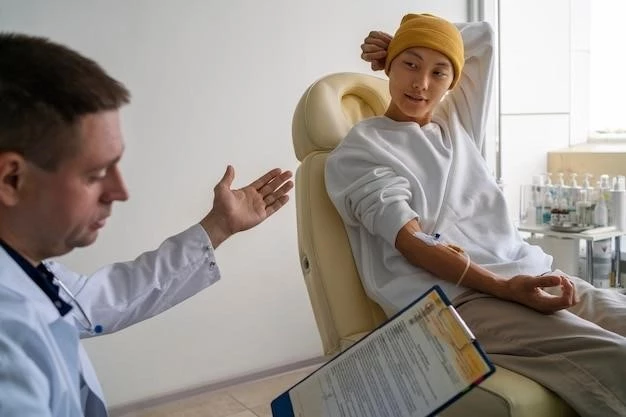Understanding Erythrokeratodermia with Ataxia
Erythrokeratodermia with Ataxia is a rare disease characterized by itchy, scaly patches on the skin․ Patients may experience neurologic symptoms such as ataxia․ Diagnosis involves identifying genetic mutations affecting keratinocytes․ The condition is autosomal dominant, often affecting the cerebellum and leading to neurological deficits․
Introduction
Erythrokeratodermia with Ataxia is a rare disease that presents with a combination of skin and neurological symptoms․ The condition manifests as itchy, scaly patches on the skin, known as erythrokeratodermia, along with neurologic deficits like ataxia․ This disorder is caused by genetic mutations affecting keratinocytes, the predominant cells in the epidermis responsible for producing keratin․

Individuals with Erythrokeratodermia with Ataxia typically develop symptoms in childhood or adolescence․ The skin manifestations can vary in severity, with some experiencing mild redness and scaling while others may have more pronounced and widespread lesions․ At the same time, the neurological symptoms, such as ataxia (a lack of muscle control during voluntary movements), can also significantly impact the individual’s quality of life․
Due to its rarity, Erythrokeratodermia with Ataxia can be challenging to diagnose and manage effectively․ This article delves into the symptoms, diagnostic process, genetic aspects, neurological implications, and treatment options related to this complex and intriguing disorder․
Symptoms of Erythrokeratodermia with Ataxia
Erythrokeratodermia with Ataxia presents a unique set of symptoms that affect both the skin and the nervous system․ The skin manifestations typically involve the development of itchy, scaly patches known as erythrokeratodermia․ These patches can vary in size and distribution across the body, causing discomfort and aesthetic concerns for individuals․
On the neurological front, patients with this condition often experience ataxia, which is characterized by a lack of coordination and balance․ Ataxia can manifest as unsteady gait, clumsiness, and difficulties with fine motor skills․ These neurologic symptoms can impact daily activities and quality of life, especially if they worsen over time․
Individuals with Erythrokeratodermia with Ataxia may also exhibit other neurologic deficits, such as muscle weakness, tremors, and speech difficulties․ The combination of skin and neurological symptoms in this rare disease presents a complex clinical picture that requires specialized care and management․
Understanding the range of symptoms associated with Erythrokeratodermia with Ataxia is crucial for timely diagnosis and intervention․ Recognition of both the skin and neurologic aspects of the condition can aid healthcare providers in developing comprehensive treatment plans tailored to the individual needs of patients affected by this rare disorder․
Diagnosis
Diagnosing Erythrokeratodermia with Ataxia involves a comprehensive evaluation of both the skin and neurologic symptoms to confirm the presence of this rare condition․ The diagnostic process typically begins with a thorough physical examination to assess the characteristic itchy, scaly patches on the skin․
Medical professionals may also conduct neurologic assessments to identify signs of ataxia and other neurological deficits in individuals suspected of having Erythrokeratodermia with Ataxia․ These assessments can include tests of coordination, balance, muscle strength, and fine motor skills to evaluate the extent of neurologic involvement․
Furthermore, genetic testing plays a crucial role in the diagnosis of Erythrokeratodermia with Ataxia․ Identifying specific genetic mutations associated with the disorder can provide definitive confirmation of the condition, differentiate it from other similar conditions, and inform treatment decisions․
Due to the rarity of Erythrokeratodermia with Ataxia and the complexity of its presentation, a multidisciplinary approach involving dermatologists, neurologists, geneticists, and other healthcare specialists may be necessary for an accurate diagnosis․ Collaboration among different medical disciplines can ensure that all aspects of the condition are properly addressed and managed․
Understanding the Genetic Mutation
Erythrokeratodermia with Ataxia is linked to genetic mutations that impact the function of keratinocytes, the cells responsible for producing keratin in the skin’s outer layer․ These mutations are typically inherited in an autosomal dominant pattern, meaning that a single copy of the altered gene from either parent can cause the condition․
The genetic mutations associated with Erythrokeratodermia with Ataxia can lead to abnormalities in the keratinocyte’s structure or function, disrupting the normal process of skin cell turnover and differentiation․ As a result, individuals affected by these mutations may develop the characteristic itchy, scaly patches of erythrokeratodermia․
Furthermore, the same genetic mutations can also impact the nervous system, specifically affecting the cerebellum, a region of the brain responsible for coordinating movement and balance․ This neurological involvement manifests as ataxia and other neurologic deficits seen in individuals with Erythrokeratodermia with Ataxia․
Understanding the genetic basis of Erythrokeratodermia with Ataxia is essential for elucidating the disease’s pathophysiology and guiding research efforts toward developing targeted therapies․ By unraveling the molecular mechanisms underlying this rare disorder, scientists and healthcare providers can work towards more effective diagnostic tools and treatment strategies to improve the quality of life for affected individuals․
Neurologic Symptoms and Deficits
Neurologic symptoms and deficits play a significant role in the clinical manifestation of Erythrokeratodermia with Ataxia․ Ataxia, characterized by a lack of muscle coordination and balance, is a prominent feature of this rare disease․ Individuals with Erythrokeratodermia with Ataxia may experience difficulties with walking, hand-eye coordination, and other motor tasks due to cerebellar dysfunction․
In addition to ataxia, patients with this condition may exhibit a range of other neurologic symptoms and deficits․ These can include muscle weakness, tremors, speech difficulties, and cognitive impairments․ The combination of skin manifestations and neurologic abnormalities in Erythrokeratodermia with Ataxia highlights the complex interplay between the skin and nervous system in this rare disorder․
The neurologic symptoms and deficits associated with Erythrokeratodermia with Ataxia can vary in severity and progression among affected individuals․ Some may experience mild neurological impairments that do not significantly impact daily functioning, while others may face more pronounced deficits that require specialized care and support․
Understanding the intricacies of the neurologic symptoms and deficits in Erythrokeratodermia with Ataxia is crucial for healthcare providers involved in the diagnosis and management of this complex condition․ By addressing both the skin and neurologic aspects of the disease, clinicians can provide comprehensive care tailored to the individual needs of each patient affected by Erythrokeratodermia with Ataxia․
Rare Disease
Erythrokeratodermia with Ataxia is classified as a rare disease, with only a limited number of cases reported in the medical literature․ The rarity of this condition poses challenges in terms of diagnosis, treatment, and research due to the limited understanding of its etiology and clinical manifestations․
As a rare disease, Erythrokeratodermia with Ataxia often presents diagnostic dilemmas for healthcare providers who may not be familiar with its unique combination of skin and neurologic symptoms․ The lack of awareness surrounding this condition can result in delayed or misdiagnoses, further highlighting the importance of increased recognition and research in the field․
In addition to diagnostic challenges, the rarity of Erythrokeratodermia with Ataxia can also impact treatment options․ Limited data on the effectiveness of different therapeutic approaches in managing this condition can make it difficult for healthcare providers to develop standardized treatment protocols tailored to individual patients․
Despite its rarity, ongoing efforts in the scientific and medical communities aim to improve understanding and management of Erythrokeratodermia with Ataxia․ Collaborative research initiatives, patient advocacy groups, and international networks dedicated to rare diseases play a crucial role in advancing knowledge and promoting better outcomes for individuals affected by this complex and enigmatic disorder․
Impact on Hands and Feet
The impact of Erythrokeratodermia with Ataxia on the hands and feet can significantly affect the quality of life for individuals living with this rare disease․ The skin manifestations of erythrokeratodermia, characterized by itchy, scaly patches, can be particularly bothersome on the hands and feet, areas essential for daily activities and mobility․
Individuals with Erythrokeratodermia with Ataxia may experience discomfort, pain, and even limitation of movement in the hands and feet due to the presence of skin lesions․ The involvement of these extremities can interfere with tasks that require fine motor skills, such as writing, typing, and grasping objects, impacting both physical abilities and emotional well-being․
Furthermore, the neurologic deficits associated with Erythrokeratodermia with Ataxia, including ataxia and muscle weakness, can compound the challenges faced by individuals in using their hands and feet effectively․ The lack of coordination and balance resulting from cerebellar dysfunction can further hinder dexterity and mobility in these critical areas of the body․
Given the impact of Erythrokeratodermia with Ataxia on the hands and feet, a multidisciplinary approach to care is essential․ Dermatologists, neurologists, physical therapists, and occupational therapists may collaborate to address the complex needs of individuals affected by this condition․ Comprehensive management strategies that target both the skin and neurologic aspects of the disease can help optimize function and improve the overall quality of life for patients․
Treatment Options
The management of Erythrokeratodermia with Ataxia involves a combination of approaches aimed at addressing both the skin and neurologic symptoms associated with this rare disease․ Treatment options may vary based on the severity of skin manifestations, neurologic deficits, and individual patient needs․
For the skin symptoms of erythrokeratodermia, topical therapies such as emollients, moisturizers, and keratolytic agents may be recommended to alleviate itching, reduce scaling, and improve skin hydration․ In some cases, topical corticosteroids or calcineurin inhibitors may be prescribed to manage inflammation and redness․
In more severe cases of erythrokeratodermia, systemic treatments such as retinoids or immunosuppressive agents may be considered to target the underlying skin abnormalities․ These medications work to regulate skin cell turnover and reduce the development of scaly patches, potentially providing relief from symptoms and improving cosmetic appearance․
When addressing the neurologic symptoms of Erythrokeratodermia with Ataxia, physical therapy and occupational therapy play crucial roles in improving coordination, balance, and fine motor skills․ These therapies aim to enhance mobility, strength, and functional abilities, helping individuals better manage activities of daily living․
Additionally, genetic counseling and support services may be beneficial for individuals and families affected by Erythrokeratodermia with Ataxia․ Genetic counselors can provide information about the inheritance pattern of the condition, facilitate genetic testing, and offer guidance on family planning considerations․
Overall, a holistic and patient-centered approach to treatment is essential in managing Erythrokeratodermia with Ataxia․ By combining dermatologic, neurologic, and supportive interventions, healthcare providers can help individuals cope with the challenges posed by this complex and rare disease, improving their quality of life and overall well-being․
